Study of the Behavior of Masonry Historical Monuments under the Influence of Seismic Loads




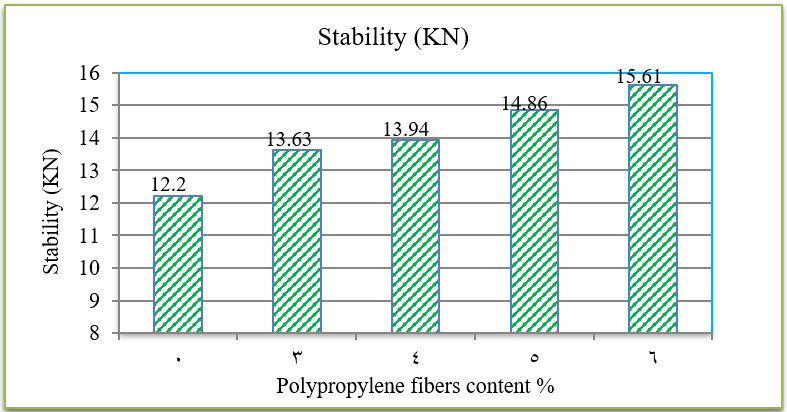

Previous studies of reinforced asphalt concrete have focused on different types of fiber such as polypropylene, polyester, carbon and glass (5-8). Polypropylene fibers provide three-dimensional reinforcement of the concrete, making it tougher and more durable (9,10). The common forms of these fibers are smooth-monofilament and have triangular shape. Polypropylene fibers are widely used as reinforcing agents in rigid and asphalt pavement (11,12). Othman (2010) investigated the effect of polypropylene application method on long-term aging of hot mix asphalt (HMA). Three different polypropylene application methods were prepared for that purpose and a constant polypropylene content of 0.7% by weight of the total mix was adapted. The first mixture was prepared using polypropylene coated aggregate. The second mixture was prepared using the traditional wet process method, where polypropylene is blended with asphalt binder at high temperature. The third mixture was prepared using the dry method where polypropylene powder was added to the mineral aggregate prior to mixing it with asphalt. Testing procedures included the Marshall tests for aged and unaged mixtures, indirect tensile strength, fracture energy, and unconfined compressive strength. This paper concluded that the inclusion of polypropylene has significantly improved indirect tensile strength, fracture energy, and unconfined compressive strength. It was also concluded that samples prepared using polypropylene coating methods displayed the highest tensile strength and fracture energy under aged and unaged conditions (13). Tapkın et al. (2009) concluded that the most suitable polypropylene fibers can be used at a dosage of 0.3% by weight of the aggregates and increased the Marshall stability values by 20% and the life of the Polypropylene fibers modified asphalt specimens under repeated creep loading at different loading patterns by 5–12 times versus control specimens. It also indicated that the addition of polypropylene fibers improves the behavior of the specimens by increasing the life of samples under repeated creep testing (14). Ahmad et al. (2015) studied the behavior of Polypropylene fibers reinforced asphalt mixtures on fatigue performance. The results from this study show that the addition of polypropylene fibers improves the behavior of the specimens by increasing the life of samples under fatigue testing according to the test results, the addition of 1.5 % of polypropylene fibers prolongs the fatigue life by 113 % in terms of number of cycles, in comparison to plain asphalt concrete beam (15). Zachariah et al. (2018) evaluated the effect of Polypropylene fibers reinforcement on bituminous concrete using brick as aggregates (first class brick and over burnt bricks). Resilient modulus tests, moisture susceptibility test, creep tests and indirect tensile strength test were performed. The Marshall test and basic property tests were used to justify the performance of polypropylene modified bituminous mixes using bricks as aggregates. This study concluded that brick aggregates can be used in asphalt concrete for using as a surface course if asphalt is modified with polypropylene fibers, and the optimum polypropylene fibers content was found to be 2% of aggregate by weight for first class bricks (where resilient modulus increased by 162%) and 4% of aggregate by weight for over burnt bricks (where resilient modulus increased by 157%). The results indicated that polypropylene fibers addition enhances the characteristics of asphalt, helps in reducing the temperature susceptibility of the mix, and fulfills the minimum requirement of tensile strength ratio TSR (16). Li et al. (2024) analyzed the viscoelastic characteristics of asphalt binders reinforced with polypropylene fibers by using dynamic shear rheological (DSR) testing. The binders reinforced with fiber showed superior resistance to high temperatures and long-term deformation while being less sensitive to temperature and having a more significant elastic characterization (17). Whereas Jalota et al. (2023) improved the moisture resistance of flexible pavements by using polypropylene fibers measuring 6 mm in length and different dosages of liquid anti-stripping agents (18). Other researches evaluated the influence of polypropylene fiber on concrete and rigid pavements (19,20), while other studies focused on hybrid reinforcement to improving performance of asphalt concrete mixtures through their reinforcement with two or more types of fibers such as: polypropylene and glass fibers (21,22), polyester and polypropylene fibers (23), glass and carbon Fibers (24), polyolefin and aramid fibers (25) and Hybrid Fiber and Nano (26).
MATERIAL AND METHODS
Asphalt binder
The Asphalt used in this study was a 60/70 penetration grade obtained from Homs Refinery Company. The Physical Characteristics of the Asphalt binder were tested according to standard specifications and are listed in Table 1.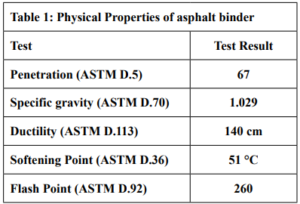 Aggregates
Aggregates
The coarse and fine aggregates were supplied from Hsia City. The gradation of the test specimens was performed in accordance with ASTM of surface course, Table 2 and Fig. 2 show the gradation of these aggregates. They were selected and incorporated in preparing all hot asphalt concrete mixes used in this study. The mechanical and physical characteristics of used aggregates have been tabulated in Table 3.
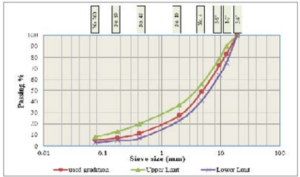
Experimental Methods
Polypropylene fibers were used in asphalt mixtures with different percentages (3, 4, 5 and 6%) by weight of the asphalt binder. polypropylene fibers were added to hot asphalt binder and mixed manually for five minutes (until the mix acquires uniformity). Then, the modified asphalt was mixed with aggregates. To determine the optimum asphalt content that would produce asphalt concrete mixtures, 15 samples were tested according to The Marshall test (ASTM.D 1559). The Marshall method is used for all mixtures. The optimum asphalt content was selected from figure. 3 as the average of the asphalt content for maximum density, maximum stability and 4% air voids. The optimum binder content was found to be 5% by weight of the total mix. All PPF modified specimens were prepared using constant asphalt binder content (5%) and produced at a mixing temperature of 160ºC.

RESULTS
Effect of Polypropylene fibers on the performance of the asphalt binder
To determine the effect of Polypropylene fibers on the physical characteristics of the asphalt, penetration, softening point, and ductility tests were carried out on both reinforced and unreinforced asphalt binder with PPF. The penetration value determines the hardness of asphalt by measuring the depth (in tenths of a millimeter) to which a standard and loaded needle will vertically penetrate in 5 seconds a sample of asphalt maintained at a temperature of 25°C (ASTM D 5). The results of the penetration test are presented in Fig. 4.
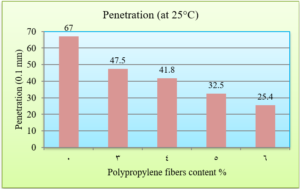
Ductility is the property of asphalt that permits it to undergo great deformation or elongation. It is defined as the distance in cm, to which a standard sample or briquette of the material will be elongated without breaking (ASTM D 113). Fig. 5 shows the change in the ductility of asphalt binder depending on the Polypropylene fiber content. As the Polypropylene content increases, the ductility values decrease.
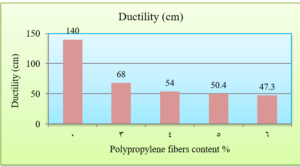
The softening point is determined as the temperature at which a sample of asphalt, subjected to a progressive increase in temperature and the weight of a steel sphere, reaches a consistence that leads to its flow through a ring of steel, until a specific deformation is obtained (ASTM D 36). The results of the softening point test are presented in Fig. 6.
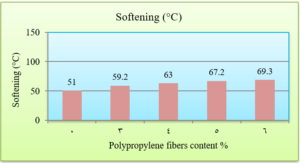
Evaluation of polypropylene fibers addition on asphalt mixtures characteristics
At this stage, 45 Marshall specimens are prepared using asphalt binder content (5%). The Marshall test results for reinforced and unreinforced asphalt mixtures are tabulated in Table 5.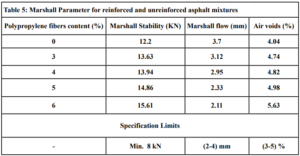
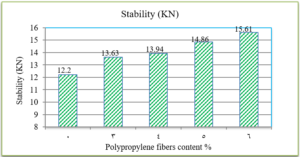
Fig. 8 indicates that as the Polypropylene fibers content increases, the Marshall flow for asphalt mixtures decreases.
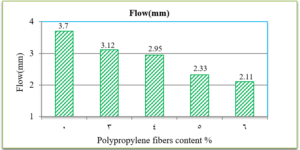
Fig. 9 presents the results of air voids percentage in the total mix for all mixtures. It indicates that polypropylene fibers have increased the air void percentage in all the specimens.
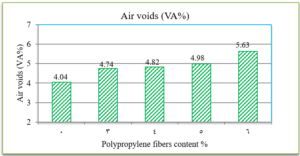
DISCUSSION
The penetration results indicate that the consistency of the PPF reinforced asphalt decreases as the PPF content in the mix increases. The reduction in penetration values were (29%, 38%, 51% and 62%) with the addition of (3%, 4%, 5% and 6%) of PPF, respectively, as compared to the unreinforced asphalt. This means that the addition of PPF makes the asphalt harder and more consistent. These results indicate that the rutting resistance of the mix is improved, but on the other hand, the high stiffness makes the asphalt concrete less resistant to fatigue cracking. It was also found in this research that the ductility values decreased as the addition percentage increased. This could be due to the position of polypropylene fibers in the cross-section of the asphalt binder during the ductility test, which prevents the asphalt from stretching easily. By increasing the Polypropylene fibers content, the softening point increased. This increase ranges from 16% to 36% with the addition of 3% to 6% of PPF content, this result indicates that the resistance of the reinforced asphalt binder to high temperatures is increased. Consequently, the results of the asphalt binder tests indicate that the reinforced asphalt samples with PPF are much stiffer and more resistant to high temperatures and rutting. The results of the Marshall tests indicate that the increasing in the polypropylene fibers content led to an increase in Marshall stability and decrease in flow values for asphalt mixtures. Increasing of 12%, 14%, 22% and 28% in stability values with the addition of 3%, 4%, 5% and 6% of PPF, respectively, to comparing with the traditional asphalt mixtures. Polypropylene fibers led to increase the air voids in all reinforced mixtures. This could have occurred because all the specimens were prepared 5% asphalt content, therefore, PPF added samples need more asphalt traditional specimens. However, the air voids of reinforced mixtures with Polypropylene fibers up to 5% content were acceptable as compared with the specification limits (3-5%) [ASTM].
CONCLUSIONS
Based on the results of studying the effect of polypropylene fibers in asphalt concrete mixtures, it can be deduced:
RECOMMENDATIONS
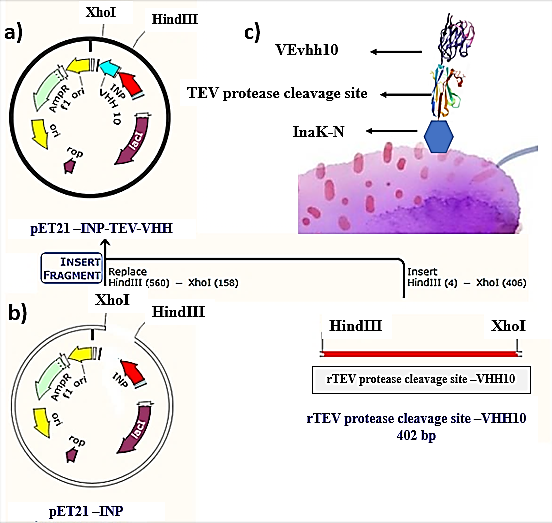
INTRODUCTION
Vascular Endothelial Growth Factor (VEGF) is a homodimeric glycoprotein with a molecular weight of approximately 28 KD. This protein serves as a critical mediator for angiogenesis, the formation of new blood vessels. VEGF exerts its physiological effects by binding to two receptors known as Flt-1 (VEGFR-I) and KDR (VEGFR-II) (1). These receptors possess seven extracellular immunoglobulin-like domains and one intracellular tyrosine kinase domain. They are expressed on the surface of endothelial cells, playing a critical role in the regulation of angiogenesis (2, 3). Under hypoxic conditions, the expression of VEGF receptors increases, leading to the induction of the angiogenesis phenomenon. The binding of VEGF to the VEGFR-II receptor stimulates the response of endothelial cells in blood vessels (4-6). Although VEGFR-I has a higher affinity for this factor, it only plays a role in sequestering VEGF and facilitates its access to the VEGFR-II receptor, which is the primary receptor mediating antigenic signaling. VEGF binds to these receptors through two distinct domains (7, 8). In healthy individuals, VEGF contributes to angiogenesis during embryonic development and plays a critical role in adult wound healing. Pathological angiogenesis is pivotal in various conditions such as tumor growth, metastasis, diabetic retinopathy, macular degeneration, rheumatoid arthritis, and psoriasis (9-11). Inhibition of angiogenesis can be achieved by several methods, including inhibition of endothelial cell signal transduction, migration, and survival, as well as modulation of factors such as growth, proliferation, matrix metalloproteinase, and bone marrow precursor cells. VEGF, as a regulator of tumor angiogenesis, exerts its angiogenic effects by binding to its receptors, especially VEGFR-II, thereby influencing the mentioned processes (12-14). Therefore, this molecule is of great importance as a valuable drug target in antiangiogenic therapies (12, 15). Single-domain antibodies, nanobodies, or VHHs possess valuable characteristics, including effective tissue penetration, high stability, and ease of humanization, efficient expression in prokaryotic hosts, and specificity and affinity for their respective antigens. Consequently, they can be introduced as alternative therapeutic candidates to traditional antibodies. VHHs represent the smallest functional unit of an antibody, preserving all of its functions, and due to their minimal size, they are also recognized as nanobodies (16-18). The studies conducted by Shahngahian and colleagues in 2015 demonstrated that VEvhh10 (accession code LC010469) exhibits a potent inhibitory effect on the binding of VEGF to its receptor (19). The mentioned VHH exerts its inhibitory role by binding to the VEGF receptor binding site. VEvhh10 also possesses the highest binding energy at the VEGF receptor binding site among other members of the VHH phage display library, covering vital amino acids involved in the biological activity of VEGF and disrupting its biological function. A standard method for expressing non-fused VHH is the use of E. coli expression systems. However, expressing non-fused VHH using conventional cytoplasmic expression methods in this prokaryotic host often leads to the formation of inclusion bodies (20, 21). In this study, to overcome this issue, a surface display technique was chosen, allowing peptides to be presented on the surface of microbial cells through fusion with anchoring motifs. The ice nucleation protein (INP) is one of the joint membrane proteins in bacteria (22-27). Despite the size limitations that most surface expression systems have regarding the display of target proteins on the cell surface, an INP-based surface expression system can express and display VHH on the bacterial surface, and overcoming the problems of cytoplasmic expression within bacteria.
MATERIALS AND METHODS
Molecular and Chemical Materials
The materials, chemicals, and reagents required for the lab are listed as follows:
Design of fusion genes and constructions of pET-INP-VHH
Gene Cloning: Primers for the amplification of the VEvhh10 gene with the accession code LC010469 were initially designed (Table 1). The plasmid containing the gene fragment served as a template for the Polymerase Chain Reaction (PCR). Amplification was carried out using Taq polymerase and Pfu polymerase enzymes in a thermocycler with a programmed temperature profile (Table 2). Various annealing temperatures for primer binding to the template were tested, and a temperature of 65°C was found to be the optimal annealing temperature. Primer cutting sites at the beginning and end of the Gene were designed, and the location of the TEV protease enzyme cutting site was positioned between the INP linker and the VEvhh10 sequence.
The VEvhh10 gene fragment, amplified by the pfu polymerase through PCR, was extracted from the gel. Simultaneously, digestion of this fragment and the pET-21a vector containing the INP linker was carried out using the HindIII and XhoI restriction enzymes. Purification was performed using a commercial enzyme purification kit. Ligation of the gene fragment into the target vector was accomplished using the T4 DNA ligase enzyme. The resulting product was incubated at 4°C overnight. The ligated product was then transferred into E. coli DH-5α bacteria. To confirm the Gene insertion into the vector, the transformed bacteria were plated on antibiotic- ampicillin containing plates. The obtained colonies were then subjected to Colony PCR using specific primers for VHH, T7 promoter, and terminator primers. The PCR products were analyzed on a 1% agarose gel, and positive transformants were screened and cultured. The recombinant plasmid was purified using a plasmid extraction kit. Enzymatic dual digestion by HindIII and XhoI was performed to confirm the insertion of the gene fragment into the plasmid.
Expression and detection of the Gene constructs InaK-N_TEV Protease
The gene structure of the InaK-N_TEV Protease was transformed in the pET-21a plasmid containing INP and VHH using a heat shock method in the E. coli BL21 (DE3) host. For protein expression, a colony from bacteria harboring the recombinant plasmid was inoculated into 10 mL LB medium supplemented with 100 mg/ml ampicillin and incubated at 37 °C with adequate aeration (250 rpm). Subsequently, 1 mL of the grown bacteria was transferred to 50 mL LB medium containing ampicillin and incubated at 37 °C until the OD600 reached approximately 0.6. Finally, expression was induced with 1 mM IPTG for 24 hours at 25 °C. The resulting product was centrifuged at 4000 rpm for 15 minutes, and the obtained pellet was stored at -20 °C until further analysis. To confirm protein expression, SDS-PAGE (Sodium Dodecyl Sulfate-Polyacrylamide Gel Electrophoresis) was performed using a 12% acrylamide gel under non-reducing conditions according to the Laemmli method (28).
The expression and purification of VEGF8-109
The pET-28a plasmid containing the VEGF8-109 gene (the domain binding to the VEGF receptor) was transformed into E. coli BL21 (DE3) bacterial cells and cultured at 37 °C overnight in Terrific Broth (TB) medium supplemented with 100 mg/ml kanamycin. Subsequently, induction was carried out with 0.5 mM IPTG at an OD600 of 0.6, and the cells were incubated at 24 °C for 22 hours (29). After centrifugation (5000 g, 15 minutes, 4 °C), the bacterial cells were sonicated in a lysis buffer containing 50 mM NaH2PO4, 300 mM NaCl, 10 mM imidazole, and 1 mM PMSF (pH 8.0). The sonication product was further centrifuged at 12000 rpm for 20 minutes at 4 °C. The resulting supernatant was analyzed using SDS-PAGE for further characterization (30). Protein purification was carried out using affinity chromatography with a nickel column. For this purpose, the protein sample was transferred onto a column that had previously reached equilibrium by washing with a wash buffer (Tris-base (50 mM, pH 8.0) + NaCl (300 mM) + Imidazole (20 mM)). At this stage, proteins lacking a histidine tag were washed out and removed from the column using this buffer. Only the target protein, due to the presence of a histidine tag, remained bound to the column. Subsequently, using the elution buffer (Tris-base (50 mM, pH 8.0) + NaCl (300 mM) + Imidazole (250 mM)) in the presence of a high concentration of imidazole, protein separation was performed. Additionally, purification was conducted using cold buffers to prevent the thermal denaturation of proteins. Following that, dialysis was performed in PBS buffer containing glycerol overnight at 4 °C, and the protein was analyzed using SDS-PAGE. Protein concentration was determined by the Bradford method with BSA as a protein standard (31).
Cell Culture
Human Umbilical Vein Endothelial Cells (HUVEC) were cultured in T25 flasks using Dulbecco’s Modified Eagle Medium (DMEM) supplemented with 5 mM glucose, 2 mM L-glutamine, 10% fetal bovine serum (FBS), 1% penicillin (100 mg/mL), and streptomycin (100 mg/mL). The cells were maintained at 37°C with 5% CO2 and used for subsequent experiments (32).
In vitro endothelial cell proliferation assay
In order to investigate the effect of VEGF8-109 on the growth and proliferation of HUVECs, the MTT colorimetric method was employed (33). A total of 5×103 cells were seeded in each well of a 96-well culture plate. After cell attachment within 24 hours, the culture medium was replaced with fresh medium containing VEGF8-109-RBD protein at various concentrations (10, 30, 60, 120, and 240 ng /mL), and the cells were incubated at 37 °C for 48 hours. Three independent assessments were performed for each treatment. For cell proliferation determination, cells were treated with 0.5 mg/mL MTT for 4 hours at 37 °C, and then the medium was carefully removed. Formazan crystals were dissolved in 100 μL of DMSO, and the absorbance was read at 570 nm using a µQuant plate reader from BioTek (USA).
ELISA-based immunoassay
The surface-expressed VHH-expressing bacterial cells, using the INP anchor, were prepared in a carbonate-bicarbonate buffer (pH 9.6, 0.1 M Na2CO3, 0.1 M NaHCO3). Subsequently, 100 μL of bacterial cells containing the INP-VEvhh10 linker were added to each well and incubated at room temperature for 16 hours. After 16 hours, the solution was aspirated, and the wells were washed three times with 100 μL of PBS buffer. Blocking was performed using a blocking buffer consisting of 2% gelatin in PBS (350 μL) for one hour at 37 °C. The blocking solution was then aspirated, and the wells were washed three times with 100 μL of PBST buffer (PBS + 0.05% Tween-20). Serial dilutions of VEGF solutions (ranging from 5.0 ng/mL to 500 ng/mL) were added to the wells and incubated for 2 hours at room temperature. After incubation, all wells were aspirated and washed thoroughly with PBST buffer. Subsequently, 100 μL of human monoclonal anti-VEGF antibody at a concentration of 1000 ng/mL was added to each well, followed by incubation in the dark at 37 °C for 1.5 hours. Then, 100 μL of Anti-Human IgG conjugated with HRP were added to each well and incubated in the dark at 37 °C for 1.5 hours. Finally, 100 μL of TMB and H2O2 were added to each well and incubated for 15 minutes in the dark. The reaction was stopped by adding 100 μL of 2 N sulfuric acid to each well. The absorbance of the wells was then read at 450 nm wavelength.
RESULTS
Construction of pET-21a-Ina_K537-TEV-VEvhh10 expression plasmid
A schematic representation of the gene structure pET-21a-Ina_K537-TEV-VEvhh10 is presented in (Figure 1) using Snapgene.v5.1.5 software. Initially, the plasmid pComb3X containing the VEvhh10 gene sequence with the accession number LC010469 in the GenBank database was registered and extracted from E. coli TG bacteria using the Gene All kit. Subsequently, the plasmid served as a template for VEvhh10 gene amplification using specific primers for the VEvhh10 gene (414bp), Taq DNA polymerase (Figure 2a), and pfu polymerase (Figure 2b). After the amplification process, the PCR product (VEvhh10) was digested with HindIII and XhoI enzymes to create cohesive ends, It has been cleaned (402bp) (Figure 2c). Additionally, the pET-21a vector containing the INP linker was linearized through digestion with HindIII and XhoI restriction enzymes for subsequent pure attachment, the results of this stage were as expected in terms of nucleotide sequence counts.
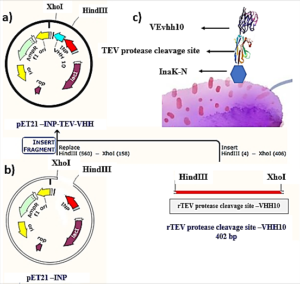

After ligation, the resulting product (pET-21a-Ina -TEV-VEvhh10) was incubated at 4℃ for 14 h and then introduced into bacteria. The transformed product was cultured on ampicillin-containing LB plates. Positive samples were isolated and confirmed for gene insertion using colony PCR. Subsequently, the extracted pET-21a-Ina_K537-TEV-VEvhh10 plasmid was used as a template for amplifying the VEvhh10 gene and the gene structure containing INP. The PCR was performed on the plasmid extraction using Forward and Reverse primers for the VEvhh10 gene 414bp as shown (Figure 3a) and, likewise, Forward and Reverse primers for the T7 promoter and terminator of the plasmid 1099bp as shown (Figure 3b). The plasmid was digested with HindIII and XhoI enzymes, resulting in the visualization of the target gene on the gel (Figure 3c). After examination, the results indicated the success and confirmation of the cloning.

Confirmation of Surface Expression Ina_K537-TEV-VEvhh10
The InaK-N_TEV Protease_Cleavage_Site_VEvhh10 structure consists of three parts: the initial 537 bp of the InaK gene from Pseudomonas syringae encoding a protein with an approximate molecular weight of 19-KD, the VEvhh10 mono body gene with 372 bp and a protein with an approximate molecular weight of 14 KD, and the coding sequence for the TEV protease cleavage site with 21bp. Therefore, the molecular weight of the unmodified InaK-N_TEV Protease_Cleavage_Site_VEvhh10 structure is around 33 KD. To investigate the surface expression of VHH, bacterial pellets were divided into three parts after expression. The first part underwent sonication, the second part was digested with lysozyme, and the third part remained as intact cells (Figure 4). Each of these fractions was also treated with the TEV protease, and the results obtained in SDS-PAGE non-denaturing gel are shown (Figure 4). The appearance of a band in the 33-KD range in SDS-PAGE for the lysed bacterial pellet induced with IPTG, in comparison to the control sample, indicates the expression of this protein. Bands in lanes 1, 3, and 5 represent the expressed surface protein in the presence of TEV protease, indicating a weak TEV protease band and an additional 19-KD band corresponding to INP. In contrast, lanes 2, 4, and 6 show bands corresponding to the expressed surface protein in the absence of TEV protease, and these bands are stronger compared to the previous condition. Additionally, due to the lack of cleavage by TEV protease, the band corresponding to INP did not appear. These results indicate the successful surface expression of VEvhh10 (Figure 5).
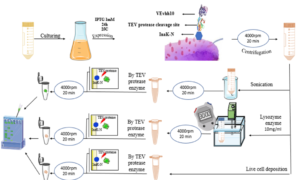
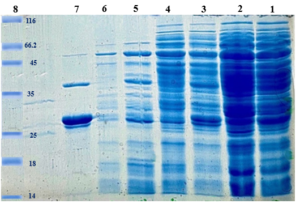
In vitro HUVECs proliferation assay
Before investigating the binding capability of the expressed VHH on the bacterial surface, the activity of the produced non-fused VEGF8-109 was assessed by its effect on the growth and proliferation of human umbilical vein endothelial cells (HUVECs) using the MTT assay. As illustrated in Figure 6, cell proliferation is well-performed with an increase in the concentration of non-fused VEGF8-109. At a concentration of 240 ng/mL, the cell population has reached approximately 80% compared to the sample lacking VEGF8-109. Therefore, the produced non-fused VEGF exhibits biological activity and can be utilized in VHH binding assays.
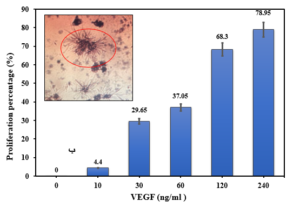
Evaluation of binding of VHHs of VEGF
In order to assess the binding capability of VEvhh10 to VEGF, an ELISA-based immune assay was employed following the mentioned method (Figure 7a). The results obtained from the dose-response curve of VEvhh10 expressed on the bacterial surface using the ELISA method (Figure 7b) demonstrated that an increase in VEGF concentration led to a higher number of anti-VEGF molecules binding to it, resulting in an enhanced optical absorption.

DISCUSSION
According to global statistics, cancer is one of the problems that the world community is facing (34). One promising approach is to inhibit angiogenesis, the formation of new blood vessels, which tumors rely on for growth. Tumor cells can undergo cell death due to oxygen and nutrient deficiency if new vascular systems do not develop. However, when the vascular system extends towards the tumor, it can continue growing. Since angiogenesis is a common requirement across many cancers, targeting it is an effective strategy for tumor elimination. Tumor cells promote vascular growth by secreting VEGF, which affects endothelial cells, triggers signaling cascades, and increases cell proliferation, migration, and survival (35, 36).Vascular endothelial growth factor (VEGF) is the key inducer of angiogenesis, which is crucial for tumor growth and metastasis. Under pathological conditions, VEGF expression significantly increases, with 60% of cancer cells upregulating VEGF to facilitate growth. VEGF promotes endothelial cell proliferation and migration, and increases vascular permeability and protease expression, aiding angiogenesis (10). Due to its pivotal role, VEGF is a primary therapeutic target. Inhibiting VEGF involves strategies like monoclonal antibodies, VEGF mutants, receptor antagonists, soluble receptors, tyrosine kinase inhibitors, anti-sense methods, and aptamers. VEGF functions by binding to its tyrosine kinase receptors (VEGFR-I and VEGFR-II), leading to receptor dimerization and phosphorylation (5). In recent years, targeted therapy using monoclonal antibodies has gained significant attention and emerged as one of the most successful strategies for treating hematologic malignancies and solid tumors. Monoclonal antibodies eliminate tumor cells through various mechanisms, including direct impacts on tumor cells (e.g., blocking receptors), immune system-mediated cell-killing, and specific impacts on tumor angiogenesis (37). While monoclonal antibodies have shown promise in targeted cancer therapy (16, 17), they also come with drawbacks like immunogenicity, high production costs, and limited tumor tissue penetration due to their large size. Effective cancer treatment requires specific properties in monoclonal antibodies, including specificity, solubility, stability, and smaller size. Efforts have focused on producing antibody fragments like scFV and Fab, which offer advantages such as enhanced tumor penetration, reduced immunogenicity, and faster production. However, challenges remain in terms of stability, expression yield, aggregation, and protease resistance, necessitating further improvements (38). In the camelid family, unique immunoglobulins lacking light chains are found in the mammalian immune system. These heavy-chain antibodies feature a VHH domain, which maintains antigen-binding ability akin to full antibodies while overcoming the challenges of conventional antibodies and engineered fragments. Their exceptional characteristics include high stability and solubility, ease of production, small size, heat, detergent, and protease resistance, high homology with human VHH fragments, high antigen affinity, ease of humanization, and engineering into multi-specific forms. Due to their small size, VHHs are expected to penetrate tumors and the retina more effectively than other antibodies. Moreover, VHHs are the only option among antibodies and their derivatives capable of crossing the blood-brain barrier. Therefore, VHHs with VEGF inhibition potential hold promise for angiogenesis inhibition in brain tumors as well (39, 40). Given the extraordinary importance of angiogenesis inhibition in cancer and other diseases, the remarkable success of monoclonal antibodies against VEGF in this field and the superiority of VHHs over other antibodies and antigen-binding fragments have been established. In this study, a surface display system using the INP linker was employed to produce VHH antibodies with high specificity and affinity against VEGF in the bacterial system. The use of a surface display system has various advantages, including low cost, easy expression, and ease of control over expression conditions (41). In this study, we employed a surface display system using the INP linker to produce VHH antibodies targeting VEGF in bacteria, addressing the challenges associated with bacterial cytoplasmic expression (40). The INP-based system offers advantages such as low cost, easy expression, and control over expression conditions. Additionally, the central repetitive region in INP can be removed to produce shorter fusion proteins for cell surface display (42). Despite size limitations in some systems, INP allows expression of proteins up to 60 kD. Various variants of INP exist, with Ina-K being the most commonly used (43), so in this study, the N-terminal region of InaK, which contains the first 537 amino acid pairs of Ina-K, was employed as an anchor motif for displaying VEvhh10 on the surface of bacterial cells. In a 2015 study, Shahangian et al. designed and constructed phages displaying single-domain antibodies targeting the region linked to the VEGF receptor. These phages exhibited binding capability to key functional regions. A phage display library on a nanobody platform was prepared, followed by enrichment and competitive screening of VHHs targeting VEGFR-II using competitive ELISA. Monoclonal VHHs with the highest affinity for the second binding domain of the VEGF receptor were sequenced and named VEvhh1, VEvhh2, and VEvhh3 (VEvhh10) based on their recurrence frequency. The gene sequences encoding these VHHs are deposited in GenBank with accession numbers LC010467, LC010468, and LC010469, respectivel(19).The results of this research indicate that the use of the surface display system with the INP linker for expressing VEvhh10 is a suitable option. This system completely eliminates the need for cell lysis and time-consuming, costly chromatographic methods. With this system, it is possible to express VEvhh10 as shown (Figure 5). Furthermore, the ELISA results and the cell proliferation assay (live-cell assay) confirm that VEvhh10 binds with high affinity to the VEGF receptor binding region, as shown in the (Figure 7.b). Ultimately, a previously unexplored INP, InaA, was successfully used to display VEvhh10 on the cell surface of E. coli BL21 (DE3) (Figure 1.c). The InaK-N_TEV Protease_Cleavage_Site_ VEvhh10 detected on SDS-PAGE was 33 kD, exactly as expected. The expression of VEvhh10 on the bacterial cell surface was verified using the INP Linker. An immunological examination was conducted using an ELISA-based immune assay to measure VEGF concentration in the presence of different VEGF concentrations. As indicated in (Figure 7.b), the results demonstrated that increasing VEGF concentration led to a higher number of anti-VEGF molecules binding (VEvhh10 expressed on the bacterial cell surface), resulting in enhanced optical absorption. This study shows that it is possible to overcome the problems of cytoplasmic expression in bacteria by using a surface expression system. This system transfers VEvhh10 to be expressed on the bacterial cell surface using a linker INP, thus overcoming the problem of incorrect folding inside the bacteria. The information obtained from this study introduces VEvhh10 as a suitable candidate for inhibiting VEGF. It has the capability to block the key functional site of VEGF, inhibiting its binding to its receptor and consequently preventing the cascade of its signaling. However, further studies and investigations are required to validate this proposal.
Acknowledgment
The Researcher expresses sincere gratitude to the Research Deputy of Tarbiat Modares University for providing laboratory facilities and financial support.

INTRODUCTION
The COVID-19 pandemic in recent years has placed a huge burden on health care systems worldwide, as well as intriguing health personnel and scientists who stood obscured with its wide-ranged clinical phenotype in patients, i.e. from regular influenza symptoms to acute respiratory distress syndrome (ARDS), and possible death [1,2]. Moreover, the infection with corona virus was accompanied by severe inflammatory and immune responses, represented by a cytokine storm, often leading to severe lung damage and requiring patient admission to intensive care units (ICUs) and mechanical ventilation at local hospitals [3,4]. The main cellular receptor for corona virus, which facilitates viral entry into cells, is angiotensin converting enzyme 2 (ACE2), a cellular receptor and a main component of the renin-angiotensin-aldosterone system (RAAS), with enzymatic activity that hydrolyzes angiotensin-II (Ang-II) into Ang-1-7 [5,6]. A second important player in the RAAS system is angiotensinogen (AGT), a peptide hormone encoded by the AGT gene, which is cleaved by the renin enzyme to produce angiotensin I (Ang-I). The enzyme angiotensin (ACE or ACE1) then converts Ang-I to Ang-II [7,8]. Ang-II binds to the AT1 receptor, mainly associated with vasoconstriction, fibrosis, inflammation and thrombosis. On the contrary, Ang-1-7, resulting from ACE2 hydrolysis of Ang-II, binds to the AT2 receptor, resulting in dilation of blood vessels and reduction of fibrosis, inflammation, and thrombosis. Thus, ACE2 produces a protective response in the lung, while high ACE activities are associated with lung and cardiovascular diseases by increasing the activity of the Ang-II/AT1R axis [5,9]. Since the beginning of the COVID-19 pandemic, a plethora of scientific reports have highlighted the importance of age and several comorbidities, including obesity and hypertension, in worsening the clinical phenotype in COVID-19 patients, linking the disruption of homeostasis in the RAAS, the immune responses, and other physiological systems to severe clinical outcomes [8,10]. Many other reports have revealed associations between COVID-19 severity and genetic variants in genes associated with the RAAS including ACE, AGT and ACE2 [11-15]. Among the key player genes that received much attention after the pandemic was the ACE2 gene. On one hand, many genetic polymorphisms were identified in ACE2 that could change the binding affinity of the corona virus spike protein, hence, increasing or decreasing its entry into target cells [12]. On the other hand, and because of ACE2 major involvement in RAAS regulation, several ACE2 gene polymorphisms were identified and linked to predisposing COVID-19 patients to comorbidities that could worsen their clinical path [16,17]. One intronic single nucleotide polymorphism (SNP) in ACE2, rs2074192, has been linked to hypertension and severity of COVID-19 [18-21]. Another intronic SNP in ACE2 gene, rs233574, has been linked to stability of ACE2 mRNA and protein [22,23]. Moreover, few reports identified an exonic SNP in the AGT gene, rs699 or M268T, which replaces methionine residue with threonine in the angiotensinogen peptide and was showed to be associated with increased susceptibility to COVID-19 [7,24]. Nevertheless, it appeared that the effects of the three aforementioned SNPs in ACE2 and AGT genes on COVID-19 severity were correlated with the studied population ethnicities, as data linked to the involvement of these SNPs in COVID-19 morbidities and co-morbidities often came contradictory, taking into consideration the varied allelic frequencies among different ethnic groups. Hence, in this report, we studied the association of the two SNPs in the ACE2 gene, rs2074192 and rs233574, in addition to the AGT rs699 SNP, with COVID-19 disease severity in a cohort of Syrian patients whose corona virus infection was previously confirmed by standard methods. We reported the allele, genotype and haplotype frequencies of the three polymorphisms in both sexes after categorizing the patients according to obesity, hypertension and COVID-19 severity.
MATERIALS AND METHODS
Subjects and Samples
Our retrospective cohort study included 54, 24 females and 30 males, non-related participants with previously confirmed COVID-19 positive disease, by PCR positive tests (22 cases) or positive chest X-ray in addition to clinical symptoms (22 cases) or positive Corona IgG (10 cases). The Study cases were classified based on 3 categories: blood pressure into (39 normotensive NT) and (15 hypertensive HT); obesity, reflected by body mass index (BMI), into (20 lean, BMI<25) and (34 overweight OW, 25<BMI<30 and obese OB, BMI>30); and finally COVID-19 status into (21 mild cases, mild symptoms) and (33 moderate cases including 17 with intense symptoms but oxygenation level >94, and 13 severe cases with intense symptoms, and 3 cases with life-threatening conditions and oxygenation level <94). Our study was approved by both the Bioethics Committee at the Faculty of Pharmacy – Damascus University, and the National Committee for Ethics of Scientific Research and Novel Technologies (CONEST), at the Higher Commission for Scientific Research. Informed consents were obtained from all subjects prior to their enrollment. Three milliliters of peripheral blood were collected on Ethylene Diamine Tetra-acetic Acid (EDTA) and stored at -20 °C.
DNA Isolation and Amplification
Molecular work and genotyping processes were performed at the pharmaceutical biotechnology and immunology laboratories- National Commission for Biotechnology, Damascus, except for DNA sequencing. Genomic DNA was isolated from blood samples using Qiagen blood DNA extraction kit (Qiagen, USA) according to the manufacturer’s protocol. DNA concentration and purity were assessed using Nano drop (Maestrogen®, Taiwan). The extracted DNA quality was verified by horizontal 1.5% agarose gel electrophoresis, followed by gel staining with ethidium bromide staining (Promega®, USA), and gel documentation (Cleaver, UK). We performed polymerase chain reaction (PCR) amplification using two sets of specific primer pairs. For both ACE2 rs2074192 and rs233574, we used forward primer 5` CAGCAAAGGGGACACTTAGACA 3` and reverse primer 5` AGCCATTTCCCATCCCAGTG 3`, with a theoretical expected amplicon size of 707 base pair (bp). For AGT rs699, we used forward primer 5` GTGGTCACCAGGTATGTCCG 3` and reverse primer 5` TATACCCCTGTGGTCC TCCC 3`, with an expected amplicon size of 291 base pair (bp). All primers were manufactured by (Eurofins, Belgium), and were designed using Primer 3 software tool and checked prior to ordering using the MFE primer bioinformatics tool (https://mfeprimer3.-igenetech.com/spec) to evade any non-specific binding to genomic DNA. PCR was performed according to standard methods using thermal cycler (SENSEQUEST®, Germany) and 2X Master Mix (Genedirex®, Taiwan). The PCR reaction mixture contained 20 ng of genomic DNA and 0.25 µm/l of each primer. PCR amplification was performed according to the following protocol including: initial denaturation for 5 min at 95° C, 35 cycles of (30 sec at 94° C, 30 sec at 57° C, and 1 min at 72° C), and a final 10 min at 72° C for final extension. PCR amplicons were analyzed by agarose gel electrophoresis, using an electrophoresis apparatus from (Cleaver, UK) and a 100 bp DNA size marker from (Genedirex®, Taiwan). DNA Sequencing was performed at (Macrogen, South Korea) according to standard protocols.
Bioinformatics & Statistical Analyses
Sequencing chromatograms were analyzed using a bioinformatics tool (Geneious® software, USA). Genotype frequencies of sample alleles were estimated by gene counting method. Statistical analyses were performed using chi-square calculator https://www.socscistatistics.com/tests/ to compare the ratios of allele and genotype frequencies, respectively, with a p-value <0.05 as significant. Finally, EXCEL T test calculator was used to compare means of age and BMI among study cases, with a p-value <0.05 for statistical significance.
RESULTS
Subjects
No significant differences were recorded concerning age and body mass index (BMI) of females and males, (Table 1). However, when subjects were divided according to blood pressure status and classified as NT and HT groups, both age and BMI were significantly higher in HT (40 yrs. and 36.8 kg/m2) compared to NT (46.7 yrs. 29.7 kg/m2), respectively, (Table 1). Additionally, overweight (OW) and obese (OB) subjects showed a significantly higher mean age (49.6 yrs.) compared to lean subjects (age 34.4 yrs.). Finally, subjects with moderate or severe COVID-19 conditions (MOD/SV) were significantly older than those with mild conditions (48.5 versus 36.6 yrs., respectively), while no significant difference appeared in BMI between MOD/SV and mild conditions.
Genotyping
Amplification of the ACE2 and AGT gene sequences was successful, with amplicons appeared with expected molecular weights (MW), ~ 700 bp for ACE2 and between 200 and 300 bp for AGT, (Fig. 1 a). For all three SNPs, homozygotes and heterozygotes were easily identified by reading the sequencing chromatograms; (GG/CC, AA/TT, or AG/TC) for rs699, (CC, CT, or TT) for rs2074192, and (TT, CC, or CT) for rs233574, (Fig. 1, b-d).
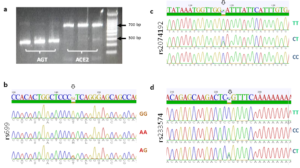
Allele Frequencies
After reading all sequencing chromatograms, alleles for all three SNPs were counted and recorded for either females or males included in any of the three categories; blood pressure, obesity, and COVID-19 condition. Of note, and since ACE2 gene occurs on X chromosome whereas AGT occurs on an autosome, for both rs2074192 and rs233574 we counted two alleles in females but only one allele in males, while for rs699 we counted the two alleles in both females and males. Table 2 shows the number of alleles in females and males recorded for each of the three SNPs, and according to the distribution of the study subjects in the three categories. The only recorded significant difference was in rs699 when comparing the T and C allele frequencies between lean versus OW/OB females, where the C allele was significantly higher in OW/OB females compared to lean females, p=0.043.
Noteworthy, a higher rs699 C allele frequency was recorded in HT compared to NT female subjects, a higher rs2074192 C allele frequency was recorded in OW/OB compared to lean subjects, a higher rs233574 C allele frequency was recorded in lean compared to OW/OB subjects, and a higher rs2074192 C allele frequency was recorded in both female and male subjects with MOD/SV compared to mild COVID-19 conditions, although none of the comparisons reached significance, p>0.05.
Genotype Frequencies
Genotypes were counted and recorded for all three SNPs. In all three categories, no significant differences were detected vis-à-vis genotype frequencies among NT and HT, lean and OW/OB, or mild and MOD/SV phenotypes. Fig. 2 shows genotype frequencies in the COVID-19 condition category for rs699 in both females and males, while it shows genotype frequencies for rs2074192 and rs233574 only in females. Since ACE2 occurs on the X-chromosome, the genotypes for either rs2074192 or rs233574 in males are the same as the allele frequencies shown in Table 2. Of note, the rs2074192 CC genotype appeared in 7 out of 14 female subjects with MOD/SV condition (50%) compared to 3 out of 10 female subjects (30%) with mild condition; the rs699 CC genotype appeared in 3 out of 14 female subjects with MOD/SV condition (21.5%) while no female had this genotype in the mild condition population; and finally the rs699 TC genotype appeared in 9 out of 19 male subjects with MOD/SV condition (47.4%) while it appeared in only 1 male out of 11 male subjects (9.1%) with mild condition.
Haplotype Frequencies
The distribution of possible haplotypes including rs2074192, rs233574, and rs699 in either female or male subjects was counted and their frequencies recorded (Tables 3 & 4). Table 3 shows the haplotype frequencies when only two SNPs are taken separately; i.e. rs2074192 and rs699, or rs2074192 and rs233574, while Table 4 shows the haplotype frequencies for all three SNPs together.
ACE2 rs2074192 – AGT rs699 Haplotypes
Table 3(a) shows all 9 possible haplotypes (32) for females and all 6 haplotypes for males. In females, the most common haplotype when considering both rs2074192 and rs699 polymorphisms was CC-TC, respectively. Among the three categories, the highest difference in haplotype frequencies was detected for TC-TC haplotype between the lean (16.7%) and OW/OB (41.7%) groups. The TT-CC haplotype was not recorded in female subjects. In males, the highest recorded haplotype for rs2074192 and rs699 was C-CC, respectively. Moreover, 6 out of 19 male subjects with MOD/SV condition had the C-TC haplotype, while no males out of 11 were recorded with this haplotype in male subjects with mild conditions. Similarly, 3 OW/OB male subjects had the C-TT haplotype, while no lean males were recorded with this haplotype.

ACE2 rs2074192 – ACE2 rs233574 Haplotypes
Table 3(b) shows all 9 possible haplotypes (32) for females and all 4 haplotypes for males. In females, the most common haplotype when considering both rs2074192 and rs233574 genotypes was TC-TC, respectively. In addition, 4 females (33.3%) had the CC-TT haplotype in the OW/OB groups, while no females had this haplotype in the lean group. Reversibly, 3 females (25%) had the CC-TC haplotype in the lean groups, while no females had this haplotype in the OW/OB group. In males, the highest recorded haplotype was C-T. Moreover, the highest difference among haplotype frequencies was detected for C-C haplotype in the mild (1 male, 9.1%) and MOD/SV (6 males, 31.6%) groups.
ACE2 rs2074192 – ACE2 rs233574 – AGT rs699 Haplotypes
Table 4 shows the 12 recorded haplotypes out of the 27 (33) possible haplotypes in females and 9 recorded haplotypes out of 12 possible haplotypes for males. In females, the most frequent haplotype among the three categories was TC-TC-TC. In addition, 3 females (25%) in the OW/OB group showed the CC-TT-TC haplotype, while no females showed this haplotype in the lean group. Contrariwise, 3 females (16.7%) in the NT group showed the CC-TT-TC haplotype, while no females showed this haplotype in the HT group. One female had the CC-TT-CC haplotype in all three groups: HT, OW/OB and MOD/SV. Of note, 15 possible haplotypes were absent in females including TT-CC-TT. In males, the highest recorded haplotype in the three categories was C-T-CC. In addition, the highest differences among haplotype frequencies were detected for C-T-TC and T-C-TC haplotypes, where 4 males (21%) in the MOD/SV groups have C-T-TC in comparison with none in the mild groups, and 3 males (15.8%) in the MOD/SV groups have T-C-TC in comparison with none in the mild groups.
Finally, among the MOD/SV group, three females aged (55, 76 and 86), and with BMI (25, 34, and 26) had a life-threatening condition that required their admission to the ICU at a local hospital. The haplotypes of the four subjects were (TC-TC-TC), (CC-CC-TC), (CC-TT-CC).
DISCUSSION
Age, Obesity, and Sex of Study Subjects
We recorded no significant differences in mean age or BMI between the 24 females and the 30 males included in this study. However, normotensive subjects were clearly younger and leaner than hypertensive subjects (Table 1). In fact, it is well known that aging and obesity are independent risk factors for raised blood pressure levels [25,26]. Moreover, it has been reported that overweight occurring at a younger age at onset is associated with a significantly increased risk of hypertension with the highest relative risk among individuals aged 18–39 years as onset of overweight [27]. As for COVID-19 severity, subjects with moderate and severe conditions were significantly older but not more obese than those with mild conditions (Table 1). In fact, the severity of COVID-19 is known to be associated with specific pre-existing conditions including age, sex, obesity, hypertension and genetic susceptibility, with mortality occurring mostly in the elderly and being about twice as high in males as in females [18,28]. Although no significant difference in BMI was found between subjects with mild compared to MOD/SV conditions (Table 1), it is noteworthy that 22 out of 30 males (73.3%) and 12 out of 24 females (50%) were overweight or obese (Table 2). This made the majority of subjects enrolled in this study as OW/OB, with the mean BMI in this group (26.9 kg/m2) already in the overweight range, and probably justifies the absence of differences in BMI between subjects with mild and MOD/SV COVID-19 conditions. Of note, no differences were found regarding sex distribution after classification of study subjects according to blood pressure and COVID-19 severity (Table 2); females (NT 75%, HT 25%; Mild 41.7%, MOD/SV 58.3%) and males (NT 70%, HT 30%; Mild 36.7%, MOD/SV 63.3%).
ACE2 rs2074192 C>T
The rs2074192 polymorphism is a variation in intron 16 of the ACE2 gene located on the X chromosome, with a global C allele frequency around 56.9% and a T allele frequency around 43.1%, European (C 55.3%, T 44.7%), African (C 68.4%, T 31.6%), and Asian (C 57.9%, T 42.1%), (www.snpedia.com). Pouladi and Abdolahi showed in silico a major effect of this SNP on the secondary structure of ACE2 RNA [23], suggesting a possible dysregulation of ACE2 transcription or translation and protein stability, and leading to a decrease in SARS-CoV-2 viral entry. In fact, many previous reports have recorded an association, although controversial, between rs2074192 with hypertension and COVID-19 severity [11,17,19,20,29]. In the Chinese population, Luo et al. demonstrated that the rs2074192 T allele was associated with essential hypertension in Chinese patients [11]. Moreover, Pan et al. reported that individuals with TC or TT genotype were associated with essential hypertension [29]. Sheikhian et al. showed that the ACE2 rs2074192 TT genotype was associated with the COVID-19 mortality in Iranian COVID-19 patients [20]. On the contrary, in Mexican patients, Martinez-Gomez et al. reported a higher C allele frequency and CC genotype frequency in COVID-19 patients with severe and critical conditions [17]. Similarly, Molina et al. showed that the T allele was protective against COVID-19 severity in a cohort of Italian patients [19]. These previous reports highlight the differences in genetic composition among different ethnicities and raise the importance of examining SNP distribution among other populations, including Syrians. Despite the fact that no significant differences were found in the current study when comparing rs2074192 allelic and genotypic frequencies between female and male subjects, the data suggest a modest association between the C allele with hypertension, obesity and COVID-19 severity as allele frequencies were higher in hypertensive females compared to normotensive peers (p value = 0.3), in OW/OB females compared to lean subjects (p value = 0.066), and in female and male subjects with MOD/SV conditions compared to those with mild conditions (p value = 0.13, and 0.12, respectively) (Table 2). In addition, the CC genotype frequency was higher in female subjects with MOD/SV compared to those with mild conditions (Fig. 2). These data are consistent with a protective effect of the T allele possibly by reducing the effect of the ACE2 enzyme that hydrolyzes Ang-II and prevents the latter’s contribution to vasoconstriction, fibrosis, inflammation, and thrombosis [8], whereas the C allele or CC genotype could be considered as risk factors.
ACE2 rs233574 T>C
The rs233574 polymorphism is an intronic variation in the ACE2 gene on the X-chromosome, with a global T allele frequency around 51.8% and C allele frequency around 48.2%, European (T 50.5%, C 49.5%), African (T 69.1%, C 30.9%), and Asian (T 30%, C 70%), (www.snpedia.com). Similar to rs2074192, the rs233574 theoretically affects the RNA secondary structure possibly leading to destabilizing the ACE2 transcript and protein [22,23]. Nevertheless, the T reference allele may additionally enhance the affinity for binding ETR-3 splicing factor, thus increasing susceptibility for COVID-19 [30]. Interestingly, most ethnic populations have comparably mid or low C allele frequency, while its frequency in the Chinese population could reach 70%, hence this allele could have been played its protective role in a large number of Chinese COVID-19 patients, although no clinical data are available to support the protective role of rs233574. Likewise, data from our study might support a protective effect for the C allele, while the T allele is a risk factor. In fact, higher T allele frequencies were detected in hypertensive females (50%) and males (55.6%) compared to normotensive peers (38.9% and 42.9%, respectively), although with no significance (p value > 0.05), and in OW/OB compared to lean female subjects (p value = 0.079), while very similar C and T allele frequencies were found in female and male subjects with MOD/SV compared to those with mild conditions (p value = 0.85) (Table 2). Finally, the TT genotype frequency was higher in female subjects with MOD/SV compared to those with mild conditions (Fig. 2).
AGT rs699 T>C
This polymorphism occurs on exon 2 in the AGT gene on chromosome 1, leading to replacement of a methionine residue with threonine in the 268 position within the primary protein structure, with a global T allele frequency around 54.5% and a C allele frequency around 45.5%, European (T 57.9%, C 42.1%), African (T 18.1%, C 81.9%), and Asian (T 17.5%, C 82.5%), (www.snpedia.com). In fact, the rs699 C allele has been reported to be associated with increased plasma angiotensinogen levels, leading to hypertension [7]. Several previous reports showed a significant association of rs699 with hypertension and/or COVID-19 severity [24,31-35]. Specifically, Mirahmadi et al. found that the rs699 C allele is a predisposing variant for coronary artery disease (CAD) in the Iranian population [32]; Repchuk et al. found that the rs699 C allele was associated with a 2.5-fold increase in systolic and diastolic BP in Ukrainian patients [33]; Yako et al. found an association between rs699 and hypertension in Tunisian and South African patients [34]; Cafiero et al. found a higher allele C (45%) and CC genotype (22%) frequencies in symptomatic compared to asymptomatic (C 31%, CC 0%) Italian COVID-19 patients [31]; and Kouhpayeh et al. demonstrated that the TC genotype and the C allele of AGT rs699 increased the risk of COVID-19 infection in Iranian COVID-19 patients [24]. Finally, Khamlaoui et al., found that rs699 was associated with high BMI, waist circumference and overweight/obesity [35]. Data from our current study demonstrated the presence of a higher rs699 C allele frequency in hypertensive compared to normotensive, OW/OB compared to lean, and MOD/SV compared to mild COVID-19, although with larger differences in females compared to males, and reaching significance only when comparing OW/OB females with lean females, p=0.043, (Table 2). In addition, the CC genotype appeared in 3 females in the MOD/SV group compared to none in the Mild groups (Fig 2). Hence, from these data, rs699 C could be extrapolated as a risk allele while T as a protective allele in relation to COVID-19 severity. Notably, all subjects included in our study were infected by COVID-19, although with a range of symptoms. Hence, comparing the allele frequencies in our subjects for all three SNPs with those previously reported in different ethnicities and populations would probably be imprecise, especially when taking into account the large differences in allele frequencies among different populations, as in the case of rs233574 and rs699. Nevertheless, when considering the allele frequency values in normotensive female subjects (Table 2), we could find out allelic frequencies of rs2074192 similar to those in most ethnicities, allelic frequencies of rs233574 similar to those in Asians but not in Europeans and Africans, and slightly higher allelic frequencies of rs699 compared to those in Europeans, but soundly different from their frequencies in Africans and Asians. In fact, the deviation of allelic frequency in the Syrian population documented in this study is not surprising taking into consideration the geographical location of Syria amid the three continents, where the genetic composition of Syrians is expected to be unique compared to most other populations because of migration and breeding influenced by several factors over thousands of years. Nonetheless, a future study reporting the allelic frequencies of all three SNPs in healthy Syrian controls would result in accurate estimates of SNP frequencies. On the other hand, it was interesting to note that the differences in allelic frequencies for all three SNPs were significant or close to significance with small p-values, only when comparing these frequencies in the obesity but not in the blood pressure and COVID-19 condition categories, specifically between lean and OW/OB female subjects (Table 2). In fact, it is very well documented that visceral obesity is a risk factor for cardiovascular disease, metabolic syndrome, hypercoagulability and vitamin D deficiency, all of which are hallmarks for COVID-19 severity [15,36,37]. Recently, Steenblock et al., identified several factors involved in the mechanism by which obesity affects COVID-19 outcome, including physical stress on ventilation, increased risk of pulmonary fibrosis, impairment of the immune system and accumulation of macrophages in adipose tissues, increasing adiponectin levels that can stimulate macrophages production of pro-inflammatory cytokines such as TNF-α, IL-6 and IL-1β, and finally activating the RAAS leading to increased blood pressure, atherosclerosis and thrombosis [38]. One could postulate that possible effects of rs2074192, rs233574, and rs699 on either blood pressure levels and/or COVID-19 severity could be occurring via indirect involvement of obesity-dependent biochemical pathways. This could be further tested on a large number of individuals who suffered from severe COVID-19 disease. Equally remarkable are the sound differences in the allele frequency profiles for all three SNPs between females and males within the obesity category (Table 2), in addition to the different distribution of rs699 genotypes between females and males within the COVID-19 category (Fig. 2). Actually, similar differences were previously reported not only for X-linked gene polymorphisms, but even for genes located on autosomes. For example, Hamet et al. showed that the T allele of rs2074192 was associated with hypertension only in obese males, while reporting a significant interaction with obesity of another SNP in the ACE2 gene, rs233575, but only in females [18]. On the other hand, Repchuk et al. showed that the rs699 C allele was associated with high systolic and diastolic blood pressure only in females [33]. As a matter of fact, sex related genotype-phenotype interactions are highly complicated and was previously tackled by many researchers. Indeed, endocrine status, in addition to genetic composition, vitally affects phenotypes and could be influenced by several factors, including differences in hormonal levels and even lifestyle habits, such as smoking and alcohol consumption, etc [39-41].
Haplotypes
Similar to the aforementioned differences in allelic and genotypic frequencies among females and males, distribution of haplotypes varied between the two sexes (Tables 3 & 4). This was clear in the different distribution of the most common haplotypes in females and males; for rs2079142-rs699, CC-TC in females, and C-CC in males; for rs2079142-rs233574, TC-TC in females and C-T in males; and for rs2079142-rs233574-rs699, TC-TC-TC in females and C-T-CC in males. This could certainly contribute to the phenotypic differences between the two sexes and explain the distinct association of certain alleles, genotypes, and haplotypes with blood pressure, obesity, and COVID-19 severity. Table 5 summarises the clearest differences in haplotype distribution among the two sexes demonstrated in Tables 3 and 4.
A review of Table 5 highlights one important finding: different haplotypes were associated with obesity only in female subjects, whereas other haplotypes were associated with COVID-19 conditions only in male subjects. Once again, this eludes to the disparity between the two sexes in terms of genetic composition and its phenotypic effects. Several preliminary conclusions might be drawn from Table 5: the rs2074192 CC genotype is probably associated with obesity in females; the rs699 TC genotype is probably not associated with either obesity or COVID-19 severity, as it was commonly distributed among females and males; the rs233574 TT or TC genotypes are probably associated with obesity; the rs2074192 C allele is associated with obesity in females and COVID-19 severity in males; and the rs2074192 T allele could be protective. Nonetheless, further studies should be performed to check for the validity of these proposals. Finally, two haplotypes were overrepresented in the HT compared to NT subjects (Table 3); the rs2074192-rs699 C-CC haplotype in males, the rs2074192-rs233574 TC-TC haplotype in females. In both cases, this could be due to the presence of the rs2074192 C allele that has previously been reported to be associated with hypertension in COVID-19 patients [17,19]. Taken together, and suggesting that the rs2074192 C allele, the rs233574 T allele, and the rs699 C allele, as risk alleles for COVID-19 morbidity and/or comorbidities, one could hypothesize that the most risky haplotype would be CC-TT-CC in females, and C-T-CC in males, while the most protective haplotype would be TT-CC-TT in females, and T-C-TT in males. Indeed, the fact that we recorded only 12 out of 27 possible haplotypes in our female population (Table 4), while the rest 15 unfound haplotypes included the TT-CC-TT haplotype might support our proposed haplotype functional classification. On the contrary, life-threatening cases could have haplotypes identical or similar to the risky haplotypes we proposed. In fact, three cases in our study population had life-threatening conditions that required them to be admitted to the ICU at local hospitals. The haplotypes of these three female subjects were (TC-TC-TC), (CC-CC-TC), (CC-TT-CC), i.e., one identical and two close haplotypes to the proposed most risky haplotype CC-TT-CC. Nonetheless, the three female subjects were elderly with ages (55, 76 and 86) and BMI (25, 34, and 26), so it is not possible to isolate the possible effect of age on COVID-19 severity in these individuals.
CONCLUSIONS
In this study, the allele, genotype and haplotype frequencies of three single nucleotide polymorphisms, ACE2 rs2074192, ACE2 rs233574, and AGT rs699 were recorded in a cohort of Syrian subjects who had previously suffered from COVID-19 disease with variable symptoms and comorbidities. We found significant association between rs699 and obesity in the female subject, while the other two SNPs showed reasonable association but without statistical significance. Based on our data and those from previous reports, we proposed the C allele for rs2074192, the T allele for ACE2 rs233574, and the C allele of AGT as risk factors for obesity and COVID-19 severity, although the association with obesity was shown only in female subjects while the association with COVID-19 severity was shown only in male subjects. We also proposed two haplotypes, rs2074192-rs233574-rs699 (CC-TT-CC in females, and C-T-CC) as risky combination for COVID-19 severity, while two haplotypes (TT-CC-TT in females, and T-C-TT in males) as protective. Our study has two main limitations; the first is the small number of studied subjects, which might have obscured significant associations. The second limitation is related to the retrospective nature of our study, which did not allow us to follow the clinical outcomes of the subjects.
ACKNOWLEDGEMENT
The authors thank Ms. Reham Antaki for her superb technical assistance.



INTRODUCTION
Single image super-resolution (SISR) is a fundamental task in computer vision aimed at recovering high-resolution details from low-resolution input images [1]. It plays a crucial role in various applications, including surveillance, medical imaging, and satellite imagery, where obtaining high-quality images is essential [1]. Over the years, numerous methods have been developed to tackle the SISR problem, with the Super-Resolution Convolutional Neural Network (SRCNN) being one of the most prominent approaches [1]. SRCNN revolutionized the field of SISR by leveraging the power of deep neural networks to learn the mapping between low-resolution and high-resolution image patches [1]. By training on a large dataset of paired low-resolution and high-resolution images, SRCNN demonstrated impressive results in terms of reconstructing detailed and perceptually pleasing high-resolution images. However, SRCNN operates using real-valued neural networks, which may not fully capture the complex nature of image data [2]. In recent years, there has been growing interest in complex-valued neural networks as a potential enhancement to traditional real-valued networks. Complex-valued neural networks extend the capabilities of their real-valued counterparts by incorporating complex numbers as part of their computations [2]. This extension allows complex-valued networks to capture and process both magnitude and phase information present in complex data distributions. When applied to SISR, complex-valued neural networks offer several potential advantages. Firstly, they can better model the complex relationships and structures inherent in high-resolution images. By considering both real and imaginary components, complex-valued networks can effectively capture the intricate details and textures that contribute to the high-frequency information in an image. This property is particularly beneficial when handling images with fine textures, edges, and patterns [3]. Secondly, complex-valued neural networks have the potential to improve the preservation of image content during the super-resolution process. The ability to represent both magnitude and phase information enables complex-valued networks to better handle the phase shift problem that often arises in SISR. This issue occurs when the high-frequency components of an image are not accurately aligned during the upscaling process, leading to blurry or distorted results. Complex-valued networks can potentially mitigate this problem by explicitly modeling the phase information and preserving the integrity of the image content [4]. In short, the main contributions in this research paper are as follows:
The remainder of this paper is organized as follows. In Section 2, we provide an overview of related works in a single image super-resolution and complex-valued neural network. Section 3 presents the methodology, describing our case study SRCNN [1] and complex-valued neural network. In Section 4, we present the experimental setup and evaluate the performance of our method on a benchmark dataset. Finally, Section 5 concludes the paper.
RELATED WORK
In recent years, single-image super-resolution (SISR) techniques have garnered significant attention in the field of computer vision, aiming to enhance the resolution and quality of low-resolution images [1]. Traditional approaches relying on real-valued networks have faced inherent limitations in capturing complex image structures and relationships, prompting researchers to explore the potential benefits of complex-valued networks in SISR and other image-processing tasks [2]. Dong et al. [1] introduced the Super-Resolution Convolutional Neural Network (SRCNN), pioneering the application of deep learning for SISR and showcasing significant improvements in image reconstruction. Building upon SRCNN, subsequent approaches such as the Fast Super-Resolution Convolutional Neural Network (FSRCNN) [3] optimized network architectures for faster processing without compromising reconstruction quality. Additionally, very deep architectures like the Very Deep Super-Resolution (VDSR) network [4], the Enhanced Deep Super-Resolution Network (EDSR) [5], and the Residual Channel Attention Network (RCAN) [6] have achieved remarkable performance by leveraging residual learning and attention mechanisms. Advancements in generative adversarial networks (GANs) have led to the development of the Super-Resolution Generative Adversarial Network (SRGAN) [7], focusing on generating perceptually realistic high-resolution images. More recently, the exploration of complex-valued neural networks has shown promise, with studies by Li et al. [8], Xu et al. [9], and Zhang et al. [10], demonstrating superior performance in capturing complex image structures and relationships. Li et al. [11] investigated the use of complex-valued networks for image de-noising, demonstrating their effectiveness in modeling complex noise patterns. Xu et al. [12] proposed a complex-valued neural network architecture for SISR, preserving phase information during the super-resolution process for sharper and more accurate reconstructions. Moreover, Zhang et al. [13] introduced a complex-valued residual network for SISR, facilitating the learning of more expressive representations and achieving improved performance. The potential of complex-valued networks extends beyond SISR, as evidenced by studies in image painting [14] and multi-modal image fusion [15]. These findings underscore the promising role of complex-valued networks in overcoming the limitations of traditional real-valued networks and enhancing various image-processing tasks.
METHODOLOGY
The Super-Resolution Convolutional Neural Network (SRCNN) is a deep learning-based technique designed for single image super-resolution (SISR). Originally introduced by Dong et al. in 2016 [1], SRCNN aims to learn the mapping between low-resolution (LR) and high-resolution (HR) image patches using a three-layer convolutional neural network (CNN). The network architecture of SRCNN comprises three primary stages (Fig 1): patch extraction and representation, non-linear mapping, and reconstruction. Each stage is detailed below:
Patch Extraction and Representation
In this initial stage, the low-resolution input image is divided into overlapping patches. These patches are the inputs to the SRCNN model and are represented as high-dimensional feature vectors. Let ILR denote the low-resolution input image, and f1 be the first convolutional layer with filter size f1×f1 and n1 filters. The output of this layer is:
F1=σ(W1∗ILR+b1)
where W1 and b1 are the weights and biases of the first layer, respectively, denotes convolution, and σ is the activation function.
Non-linear Mapping
The high-dimensional feature vectors from the first stage are input into a second convolutional layer that performs non-linear mapping. This layer uses a set of learnable filters to capture the complex relationships between the low-resolution and high-resolution patches. Let f2 denotes the filter size of the second convolutional layer with n2 filters. The output is given by:
F2=σ(W2∗F1+b2)
where W2 and b2are the weights and biases of the second layer.
Reconstruction
In the final stage, the feature maps from the non-linear mapping layer are processed by a third convolutional layer that aggregates the information to generate the high-resolution output. Let f3 denotes the filter size of the third convolutional layer with n3 filters. The high-resolution output image IHR is obtained as:
IHR=W3∗F2+b3
where W3 and b3 are the weights and biases of the third layer. The final high-resolution image is reconstructed by combining the outputs from all patches in the overlapping regions. By leveraging these three stages, SRCNN effectively transforms low-resolution images into high-resolution counterparts, enhancing image quality and details [1].

In this research, we propose a novel complex-valued neural network architecture for enhancing single image super-resolution (SISR). This approach builds upon the success of the Super-Resolution Convolutional Neural Network (SRCNN) model, but with a key distinction: we transformed the SRCNN architecture to incorporate complex-valued operations.
Traditional CNNs for SISR rely on real-valued numbers for computations. While these models have achieved significant results, recent research explores the potential of Complex-Valued Neural Networks (CVNNs) in this domain. CVNNs leverage complex numbers, which hold both magnitude and phase information, potentially offering advantages over real-valued approaches [16].
Natural images contain crucial phase information alongside magnitude. Standard CNNs primarily focus on magnitude, potentially losing details during super-resolution. CVNNs, by incorporating complex numbers, can explicitly handle both aspects, leading to potentially sharper and more accurate reconstructions [16].
Traditional SISR methods often suffer from phase shifts, introducing artifacts and distortions [17]. CVNNs, by explicitly dealing with phase information, can address this issue and generate more realistic super-resolved images.
The SRCNN model serves as a strong foundation for SISR tasks due to its effectiveness. However, to enable complex-valued computations within the network, we introduce several modifications and transformations to the original SRCNN architecture. These modifications are detailed below:
 where j is the imaginary unit [16].
where j is the imaginary unit [16].
Where and are the complex-valued weights and biases of the first layer, ∗ denotes convolution, and σ is the activation function applied to complex numbers [16, 17].
![]() where: d represents a complex-valued input.Re{d} and Im{d} denote the real and imaginary parts of d, respectively. j is the imaginary unit. ReLU is the standard Rectified Linear Unit activation function. CReLU’s simplicity and effectiveness make it a prevalent choice for complex-valued neural networks.
where: d represents a complex-valued input.Re{d} and Im{d} denote the real and imaginary parts of d, respectively. j is the imaginary unit. ReLU is the standard Rectified Linear Unit activation function. CReLU’s simplicity and effectiveness make it a prevalent choice for complex-valued neural networks.
Nearest Neighbor Upsampling (Mathematical Definition): For each new pixel location in the upsampled output, this method simply replicates the value of the nearest neighboring pixel in the original complex-valued input.
Bilinear Interpolation for Complex Data:
Bilinear interpolation for complex-valued data builds upon the concept of standard bilinear interpolation used for real-valued images. Here’s a breakdown of the general approach:
 where: L represents the CMSE loss value. Δx and Δy represent the differences between the real parts (x) and imaginary parts (y) of the predicted (zpredicted) and ground truth (zgt) complex numbers, respectively. By incorporating these modifications and transformations, our complex-valued neural network should be able to effectively capture the complex structures and relationships present in high-resolution images. This architecture enables the network to leverage the benefits of complex numbers and provide enhanced super-resolution capabilities compared to traditional real-valued networks.
where: L represents the CMSE loss value. Δx and Δy represent the differences between the real parts (x) and imaginary parts (y) of the predicted (zpredicted) and ground truth (zgt) complex numbers, respectively. By incorporating these modifications and transformations, our complex-valued neural network should be able to effectively capture the complex structures and relationships present in high-resolution images. This architecture enables the network to leverage the benefits of complex numbers and provide enhanced super-resolution capabilities compared to traditional real-valued networks.
Experimental Results
Dataset and Evaluation Metrics
To evaluate the performance of our complex-valued network (C-SRCNN) and compare it with the traditional SRCNN, we utilize standard benchmark datasets commonly used in single image super-resolution (SR) tasks. These datasets consist of diverse, high-resolution (HR) images paired with their corresponding low-resolution (LR) counterparts. The datasets are typically split into training, validation, and testing sets to ensure robust model evaluation.
We specifically chose a set of benchmark datasets encompassing various image types, including natural scenes, objects, and textures. This selection considers the potential increase in parameter size for our C-SRCNN due to its complex-valued nature compared to the real-valued SRCNN. This diversity allows us to assess the trade-off between achieving high reconstruction quality and model complexity. Additionally, it enables us to evaluate the generalization capability of C-SRCNN for handling different image content compared to the traditional SRCNN.
Here’s a detailed breakdown of the chosen benchmark datasets:
Set5: Contains 5 pairs of LR and HR images with a resolution of 256×256 pixels.
Set14: Contains 14 pairs of LR and HR images with a resolution of 512×512 pixels.
BSD100: Contains 100 HR images with a resolution of 512×512 pixels. Commonly used for SR tasks and other image processing applications.
Urban100: Contains 100 HR images with a resolution of 512×512 pixels captured from urban scenes.
To quantify the performance of our models, we employ standard metrics used in SR tasks: Peak Signal-to-Noise Ratio (PSNR) and Structural Similarity Index Measure (SSIM). Higher PSNR values indicate better image quality by measuring the ratio between the reconstructed image’s signal and noise. SSIM goes beyond just intensity differences and considers structural similarities between the reconstructed image and the ground truth, providing a more comprehensive evaluation.
Training and Evaluation
We used the T91 training set, which consists of 91 images, to train C-SRCNN. To ensure the generalizability of our C-SRCNN, we evaluated it on multiple standard benchmark datasets commonly used in single image super-resolution (SR). These datasets include Set5, Set14, BSD100, and Urban100. We compared the performance of our C-SRCNN against its real-valued counterpart, R-SRCNN. The training was conducted on a computer running Linux Ubuntu 18 with an Nvidia GTX 1060 GPU.steps =200000 and epochs = 219 patch = 128 . The quantitative results are presented in Table 1 and Table 2. Our proposed method achieved superior PSNR and SSIM scores on all four datasets compared to SRCNN-915. The PSNR results indicate an improvement of 0.435 for CSRCNN-915.
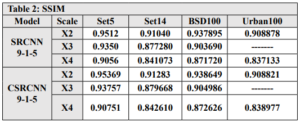
In addition, the SRCNN network was trained using different filter sizes in each layer. The number of parameters for each network was compared, and the results showed that the C-SRCNN network outperformed despite having fewer parameters. This highlights the effectiveness of the complex-valued network architecture in extracting image features, leading to superior performance. In conclusion, the results in Table 3 strongly support the efficacy of the C-SRCNN architecture for enhancing single-image super-resolution. This approach demonstrates the potential of complex-valued networks to achieve high-quality results with more efficient parameter usage.
Subjective visual assessment demonstrates the effectiveness of the C-SRCNN algorithm in enhancing the quality of single-image super-resolution (SISR) images. This algorithm excels in preserving detail sharpness, color accuracy, and noise reduction compared to the Real-SRCNN algorithm.
By utilizing these evaluation metrics, we can objectively assess the performance of our complex-valued network in enhancing single-image super-resolution. We compare the results obtained from our complex-valued network with those achieved by the traditional SRCNN. This comparison allows us to determine the effectiveness of the complex-valued network architecture in capturing complex image structures and improving the overall quality of super-resolved images.
RESULTS AND ANALYSIS
The transformation of SRCNN with complex-valued neural networks offers several benefits. Firstly, it allows for better preservation of fine details and textures during the super-resolution process. The complex-valued convolutions enable the network to capture subtle variations in color and texture, resulting in more visually appealing and realistic high-resolution images. Additionally, the complex-valued network can handle complex-valued input data, making it suitable for applications involving complex image representations. However, there are also challenges associated with complex-valued neural networks, including increased computational complexity and the interpretability of complex-valued networks may be more challenging compared to real-valued networks. In the future, researchers can focus on developing more efficient training algorithms and exploring novel architectures that leverage the power of CVNNs for SISR. Furthermore, the creation of comprehensive complex-valued data sets can facilitate the training and evaluation of CVNN-based SISR models.
CONCLUSIONS
Complex-valued CNNs present a promising avenue for advancing the field of image super-resolution. By incorporating complex-valued representations and making the necessary modifications, we can enhance the capabilities of CNNs for various image-processing tasks. The inclusion of magnitude and phase information, along with rotation and shift invariance, empowers the CV-CNNs to produce more accurate and visually appealing results. While challenges exist, further research and exploration of complex-valued CNNs hold great potential for improving image analysis and processing techniques.

INTRODUCTION
In recent years, deep learning models have exhibited remarkable performance in numerous Natural Language Processing (NLP) tasks, such as parsing [1], text classification [2], [3] and machine translation [4]. These models are typically characterized by their substantial parameter count, often reaching millions, necessitating extensive data for training to prevent overfitting and enhance generalization capabilities. However, collecting a sizable annotated dataset proves to be a laborious and costly endeavour. To mitigate the data-hungry nature of deep learning models, an approach known as automatic data augmentation has emerged. This technique involves generating synthetic data samples to augment the training dataset, effectively serving as regularization for the learning models. Data augmentation has been actively and successfully employed in computer vision [5], [6], [7] and speech recognition tasks [8], [9]. In these domains, methods frequently rely on human knowledge to apply label-invariant data transformations, such as image scaling, flipping, and rotation. However, natural language processing presents a different challenge, as there are no straightforward rules for label-invariant transformations in textual data. Even slight changes in a word within a sentence can drastically alter its meaning. Consequently, popular data augmentation techniques in NLP focus on transforming text through word replacements, either using synonyms from manually curated ontologies, such as WordNet [10] or leveraging word similarity measures [11], [12]. Nonetheless, this synonym-based approach can only be applied to a limited portion of the vocabulary since finding words with precisely or nearly identical meanings is rare. Furthermore, certain NLP data augmentation methods are specifically designed for particular domains, rendering them less adaptable to other domains [13]. As a result, developing more versatile and effective data augmentation techniques remains a significant research challenge in the field of NLP. In recent researches, a straightforward yet highly impactful data augmentation technique called Mixup [7] has been introduced, demonstrating remarkable effectiveness in improving the accuracy of image classification models. This method operates by linearly interpolating the pixels of randomly paired images along with their corresponding training targets, thereby generating synthetic examples for the training process. The application of Mixup as a training strategy has proven to be highly effective in regularizing image classification networks, leading to notable performance improvements. Mixup methodologies can be classified into input-level Mixup [14], [15], [16] and hidden-level Mixup [17] depending on where the mix operation occurs. In the context of natural language processing (NLP), applying Mixup poses greater challenges compared to computer vision due to the discrete nature of text data and the variability in sequence lengths. As a result, prior efforts in Mixup for textual data [18], [19] have put forth two strategies for its application in text classification: one involves performing interpolation on word embedding, while the other applies it to sentence embedding. This incentive drives us to explore Mixup text techniques for low-resource languages, specifically concentrating on Arabic sentiment classification. Our study involves a comparative analysis of basic LSTM classification models, both with and without the incorporation of Mixup techniques. Furthermore, we conduct experiments on diverse datasets, spanning sample sizes varying from hundreds to thousands per class. Additionally, we perform an ablation study to investigate the effects of different Mixup parameter values. To the best of our knowledge, this represents the pioneering research utilizing Mixup in the context of Arabic text classification.
MATERIALS AND METHODS
Mixup Concept
Define abbreviations and acronyms the first time they are used in the text, even after they have been defined in the abstract. Abbreviations such as IEEE, SI, MKS, CGS, sc, dc, and rms do not have to be defined. Do not use abbreviations in the title or heads unless they are unavoidable. The concept of Mixup involves creating a synthetic sample through linear interpolation of a pair of training samples and their corresponding model targets. To elaborate, let us consider a pair of samples denoted as (xi, yi) and (xj, yj), where x represents the input data, and y is the one-hot encoding representation of the respective class label for each sample. The process of generating the synthetic sample is as follows: where λ could be either fixed value in [0; 1] or it is sampled from Beta distribution with a hyper-parameter Beta (α; α). The synthetic data generated using this approach are subsequently introduced into the model during training, aiming to minimize the loss function, such as the cross-entropy function typically employed in supervised classification tasks. To achieve computational efficiency, the mixing process involves randomly selecting one sample and pairing it with another sample drawn from the same mini-batch.
where λ could be either fixed value in [0; 1] or it is sampled from Beta distribution with a hyper-parameter Beta (α; α). The synthetic data generated using this approach are subsequently introduced into the model during training, aiming to minimize the loss function, such as the cross-entropy function typically employed in supervised classification tasks. To achieve computational efficiency, the mixing process involves randomly selecting one sample and pairing it with another sample drawn from the same mini-batch.
Mixup for text classification
In contrast to images that comprise pixels, sentences are composed of sequences of words. Consequently, constructing a meaningful sentence representation involves aggregating information from this word sequence. In typical CNN or LSTM models, a sentence is initially represented as a sequence of word embedding and then processed through a sentence encoder. Commonly used sentence encoders include CNN and LSTM architectures. The resulting sentence embedding, generated by either CNN or LSTM, is subsequently passed through a softmax layer to generate the predictive distribution encompassing the possible target classes for making predictions. In [18], Guo introduced two variations of Mixup tailored for sentence classification. The first variant, referred to as wordMixup, employs sample interpolation within the word embedding space. The second variant, known as senMixup, performs interpolation on the final hidden layer of the network just before it is fed into the standard softmax layer to generate the predictive distribution across classes. Specifically, in the wordMixup technique, all sentences are first zero-padded to a uniform length. Subsequently, interpolation is performed for each dimension of every word within a sentence. Let us consider a given text, such as a sentence consisting of N words, which can be represented as a matrix B in an N × d form. Here, each row t of the matrix corresponds to an individual word, denoted as Bt, and is represented by a d-dimensional vector obtained either from a pre-trained word embedding table or randomly generated. To formalize the process, let (Bi, yi) and (Bj, yj) be a pair of samples, where Bi and Bj represent the embedding vectors of the input sentence pairs, and yi and yj correspond to their respective class labels, represented in a one-hot format. For a specific word at the t-th position in the sentence, the interpolation procedure is applied. The process can be formulated as:
The obtained novel sample〖(B ̃〗^ij;y ̃^ij) is subsequently employed for training purposes. As for senMixup, the hidden embeddings for both sentences, having identical dimensions, are initially generated using an encoder like CNN or LSTM. Following this, the pair of sentence embeddings, f(Bi) and f(Bj), is linearly interpolated. In more detail, let f represent the sentence encoder; thus, the sentences Bi and Bj are first encoded into their corresponding sentence embedding, f(Bi) and f(Bj), respectively. In this scenario, the mixing process is applied to each kth dimension of the sentence embedding as follows. The sentMixup usually applies Mixup directly before the softmax while we experimented with an additional Mixup type that works on the hidden layers output similar to [17] applying Mixup before the final linear layer. Th proposed models’ structures are represented in Fig. 1.
The sentMixup usually applies Mixup directly before the softmax while we experimented with an additional Mixup type that works on the hidden layers output similar to [17] applying Mixup before the final linear layer. Th proposed models’ structures are represented in Fig. 1.
We performed experiments using 8 Arabic sentiment classification benchmark datasets: ArSarcasm v1 [36] & v2 [37], SemEval2017 [38], ArSenTD-LEV [39], AJGT [40], ASTD-3C [41], MOV [42]. The training sets differ in size (from 12548 to 1524), and in number of labels (2 to 5). The used datasets are summarized in Table 1.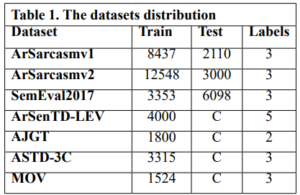 Preprocessing
Preprocessing
The effectiveness of sentiment analysis models greatly depends on the quality of data preprocessing, which is equally critical as the model’s architectural design. Preprocessing involves cleaning and preparation of the text data for the classification process. Textual data, particularly when sourced from the internet, tends to be unstructured, necessitating additional processing steps for proper classification. The noise removal step during text data preprocessing involves eliminating several elements to enhance data quality. These elements encompass punctuation marks, numbers, non-Arabic text, URL links, hashtags, emojis, extra characters, diacritics, and elongated letters. Regular expressions serve as the primary technique for noise removal, effectively filtering out unwanted text.
Experimental environment and hardware
The experiments were developed using Python 3.9.7. The experiments, including their development, implementation, execution, and analysis, were conducted on an ASUS ROG G531GT Notebook. This machine runs Windows 11 and is equipped with a 9th generation Intel Core i7 processor, 32GB of RAM, a 512GB NVMe SSD, and an NVIDIA GeForce GTX 1650 4GB graphics card. The software libraries used in this study include PyTorch, Scikit-learn, Pandas, Gensim, and NumPy.
Model
We conducted an evaluation of wordMixup and senMixup using both CNN and LSTM architectures for sentence classification. In our setup, we employed filter sizes of 3, 4, and 5, each configured with 100 feature maps, and a dropout rate of 0.5 for the baseline CNN. For the LSTM model, we utilized 3 hidden layers, each comprising 100 hidden state dimensions, with the activation function set to tanh. Additionally, the mixing policy parameter is set to the default value of one. In cases where datasets lacked a standard test set, we adopted cross-validation with a k-fold value of 5 and reported the average performance metrics. Our training process utilized the Adam optimizer [36] with mini-batches of size 32 with 30 epochs and a learning rate of 1e-3. For word embedding, we employed 100-dimensional Aravec embedding.
DISCUSSION
Across the datasets, it is evident that applying Mixup techniques generally leads to slight improvements in accuracy compared to the baseline None model. However, the effectiveness of Mixup varies depending on the dataset. For instance, on the AJGT dataset, all Mixup variants consistently outperform the None model, with Mix-encoder and Mix-output achieving the highest accuracy of 85.2%. On the other hand, for the SemEval2017 and ArSenTD-LEV datasets, Mixup provides only marginal gains, suggesting that the impact of Mixup might be more prominent in certain scenarios. Additionally, while Mixup seems to be beneficial in some cases, it does not necessarily lead to performance improvements across all datasets. For instance, on the MOV dataset, the Mixup variants show comparable or slightly worse results compared to the None model. Furthermore, it is worth noting that the Mix-encoder and Mix-output models tend to perform better than the Mix-embed model in most cases. This could be attributed to the advantage of applying Mixup at the higher levels of the model architecture, which allows the model to capture more abstract and meaningful patterns. Mixup augments data by interpolating sequences, which can create new variations that capture a broader range of sequential patterns. LSTMs, with their capability to understand and generalize sequences over long contexts, can leverage these variations more effectively than CNNs, which focus more on local patterns and may not fully utilize the sequential nature of the augmented data. Overall, these results demonstrate that Mixup techniques can be advantageous to sentiment analysis tasks, but their effectiveness is influenced by the dataset characteristics and the specific Mixup strategy used.
CONCLUSIONS AND RECOMMENDATIONS
Taking inspiration from the promising results of Mixup, a data augmentation technique based on sample interpolation used in image recognition and text classification, we conducted an investigation into three variations of Mixup for Arabic sentiment classification task, which is the first study on Mixup in Arabic to our knowledge. Our experiments demonstrate that the application of Mixup leads to improvements in accuracy and Macro F1 scores for both CNN and LSTM text classification models. Notably, our findings highlight the effectiveness of interpolation strategies as a domain-independent regularizer, effectively mitigating the risk of overfitting in sentence classification. These results underscore the potential of Mixup as a valuable tool in the field of NLP for enhancing model generalization and performance across various sentence classification tasks. In our future research endeavors, we have outlined our intentions to explore and examine further proposed variations of Mixup. Among these variants are AutoMix [44], a method that adaptively learns a sample mixing policy by leveraging discriminative features, SaliencyMix [32], which synthesizes sentences while maintaining the contextual structure of the original texts through span-based mixing and EMTCNN [45], an Enhanced Mixup that leverage transfer learning to address challenges in Twitter sentiment analysis. We are also interested in questions related to the visual appearance of mixed sentences and the underlying mechanisms responsible for the efficacy of interpolation in sentence classification. These inquiries will provide valuable insights into the potential applications and benefits of various Mixup techniques, contributing to the advancement of NLP tasks, particularly those focused on sentence classification.
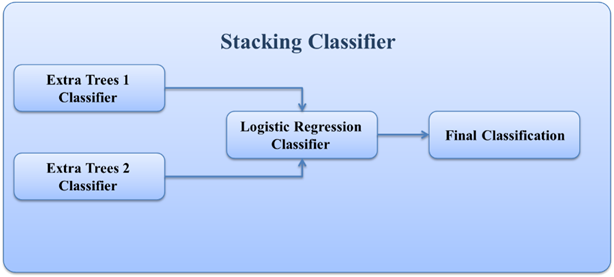
Journal:![]() Syrian Journal for Science and Innovation
Syrian Journal for Science and Innovation
Abbreviation: SJSI
Publisher: Higher Commission for Scientific Research
Address of Publisher: Syria – Damascus – Seven Square
ISSN – Online: 2959-8591
Publishing Frequency: Quartal
Launched Year: 2023
This journal is licensed under a: Creative Commons Attribution 4.0 International License.